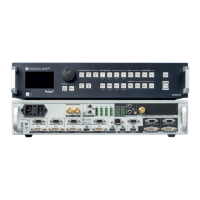8
3. Terms and denions
3. TERMS AND DEFINITIONS
BACKGROUND: a “Background” is a source, typically originang from a computer. Pulse² enables you to work
with sll (frame) background — visually in back of all other sources.
LAYER: a “layer” is an image display element (such as a PIP window, Key, logo or Background) that has a visual
priority — either in front (or in back) of another layer. 1 frame non-resizable, up to 2 live layers resizable and
2 logos available on the Pulse².
PIP: a “PIP” (Picture In Picture) is a picture, typically of reduced size, which is posioned over another
background image or other PIPs. PIPs can be reposioned, reduced, enlarged and displayed with borders.
PIPs can overlap, depending on their visual priority. Pulse² oers various slides, wipes, and fades for dynamic
PIP entrances and exits. A “ying” PIP is also possible using vercal, horizontal, or diagonal movement. A PIP
is considered as a layer.
FRAME: a “frame” is a full screen image which is selected from one of the sll frames you can capture. A
frame can be captured in ash memory from any video or computer source plugged into the machine.
LOGO: a “logo” is a part of a screen image that can be captured in ash memory from any video or computer
source, by keying or image cut-out. A logo can be posioned anywhere on the screen.
KEYING: “Key” is an electronic process whereby a video image is electronically superimposed over another
source or background, by dynamically removing a poron of the rst image. For example, removing all content
of a certain color (such as green or blue) is called a Chroma Key, and removing content based on its brightness
or luminance levels is called a (Luma Key). Keys are typically used for tles, logos and special eects. Pulse²
allows you to key a live source (such as a camera shot with green or blue background, or a tle with a black
background) over any other source or sources.
SEAMLESS: Clean transion with no glitch or loss of sync while switching between two sources. For example,
fading through black to another source is a seamless transion.
TRUE SEAMLESS: Clean seamless transions with no glitch or freeze between two sources. For example,
crossfading from source to source is a true seamless transion.
RCS²: Remote Control Soware used to control, set up, and operate the device.
QUICK FRAME: The “Quick Frame” feature allows the instant display of a stored frame above all layers.

